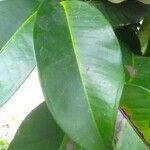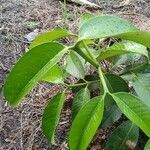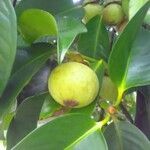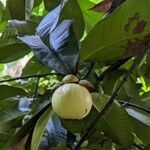Tree to 20 m high, agamospermous; exudate yellow. Twigs ±terete, some ribbing. Leaves glabrous; petiole 10–30 mm long, not channelled on fresh specimens, slightly channelled when dry, ligulate; lamina discolorous, coriaceous, elliptic, broadly elliptic, ovate or oblancelote, 10–25 cm long, 4.5–10.5 cm wide, base cuneate or obtuse, margin narrowly recurved, apex acute, shortly acuminate or obtuse; venation brochidodromous, primary vein distinctly raised on both sides, secondary veins 15–17 pairs, prominent, angle of divergence from primary vein 50–70o, 2 intramarginal veins, outermost 0.5–2 mm from margin, innermost 3–7 mm from margin. Male flowers unknown. Female inflorescences terminal, a solitary flower, pairs or rarely in 3s. Female flowers 25–60 mm diam.; sepals 4, 2-whorled, c. 20 mm long; petals 4, erect to spreading, broadly obovate or orbicular, c. 25 mm long, cream, pink or reddish; staminodes up to 20, shorter than ovary; ovary 4–8-locular. Fruit a dry berry with thick corky-leathery pericarp c. 9 mm wide, globose or depressed globose, 35–70 mm diam., purple to blackish, sepals and 4–8-rayed stigma persistent.
More
A medium sized tree 10-20 m high with bright glossy leaves. Trees keep their leaves all year. Leaves are 15-25 cm long and leathery. Male and female flowers are on separate trees. Commercial trees only have female flowers. Male trees occur but are rare. Flowers are produced on shoots near the end of branches. Female flowers have 4 cream petals and 4 sepals and a round ovary with a thick stigma composed of 4 to 8 lobes. No pollination is required because fruit develop without fertilisation. The fruit is dark blue with 4-8 white juicy segments inside the thick skin. Each segment is enclosed in fine pinkish veins. It is 8 cm across and has flower sepals attached to the stalk end. It leaks yellow sap from wounds. Fruit is produced on side branches near to the tips of the main branches. Fruit often have no seeds or up to 2. These are not true seeds but they will grow.
It is a tropical plant. It needs a hot humid climate (25°C to 35°C). Temperatures below 5°C will kill the plant and temperatures below 20°C slow growth. It grows from sea level up to 1000 m altitude in the equatorial tropics although they grow very slowly at this altitude. It can stand light shade. It often does not do well with sea breezes, and needs protection from wind. It cannot tolerate drought. It needs fertile soil. Good fertility enables earlier bearing. It suits high rainfall areas over 2500 mm per year. It cannot tolerate alkaline soils. It needs a pH between 5.5-6.8. It grows between 10°N-10°S. It suits hardiness zones 11-12.
More
The tree is mostly known from cultivation, but is also probably wild on hillsides and ridges in undisturbed mixed dipterocarp forests at elevations up to 200 metres.
Mangosteen is widely cultivated for its edible fruit which has a hard deep purple thick rind enclosing white-transparent juicy segments. It is eaten fresh, dried and as a flavouring. The clear juices stain brown. Also used in cosmetics, including skin and hair products. Garcinia mangostana has been used medicinally, particularly in SE Asia, and there are various debated health benefits (e.g. Marcason 2006, Pedraza-Chaverri et al. 2008, Williams 2012: 229). There are numerous scientific papers and reports on the chemical properties and potential medical uses of the Mangosteen; reported having anti-inflammatory, antifungal and antiviral properties.
More
Fruit is best eaten fresh. It is the arillus or layer around the seeds which is eaten. They are also cooked and used in desserts. The seeds are eaten after boiling or roasting. They can be ground to produce a vegetable butter.
Trees breed true from seed because they are produced asexually. This means trees are very uniform. As well some seeds can produce more than one seedling. They germinate between 10 and 54 days. Seeds need to be fresh (less than 5 days after extraction) and undamaged, and cleaned of pulp. They quickly lose their viability. Transplanting is done with care after 2 years. Long tap roots make this difficult. Young trees require shade during hot weather. The slow early growth is because the original roots of the seedling are replaced by new roots from the base of the stem. A spacing of 7-10 m suits. Grafting onto vigorous root stocks is difficult. It has been performed on Garcinia tinctoria. Budding, cuttings and layering have been unsuccessful.





